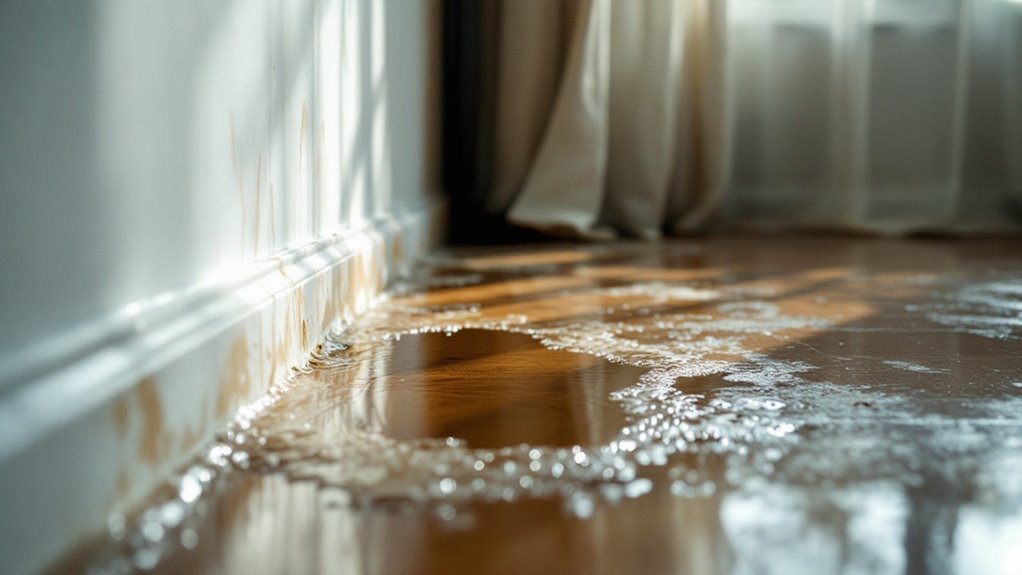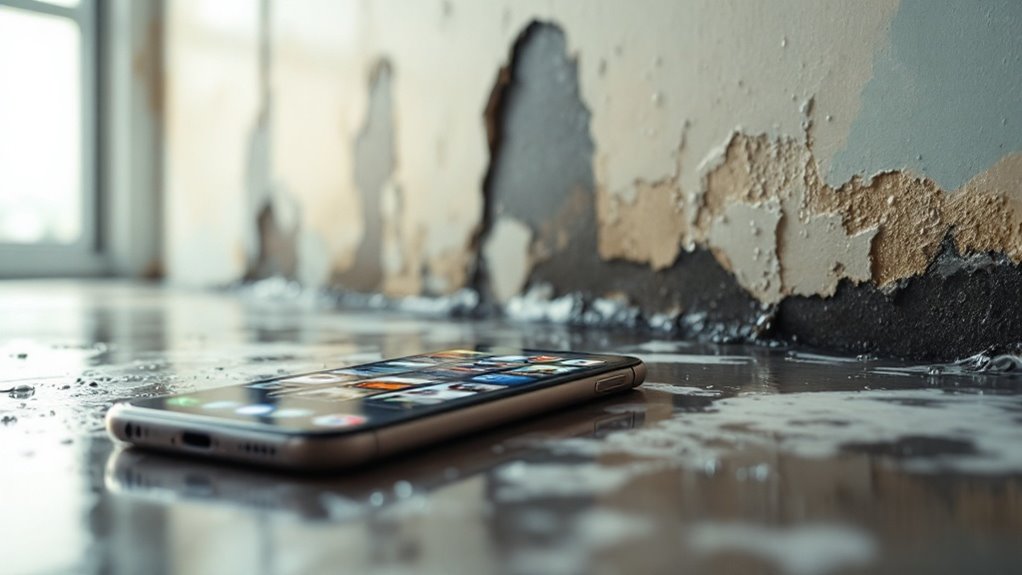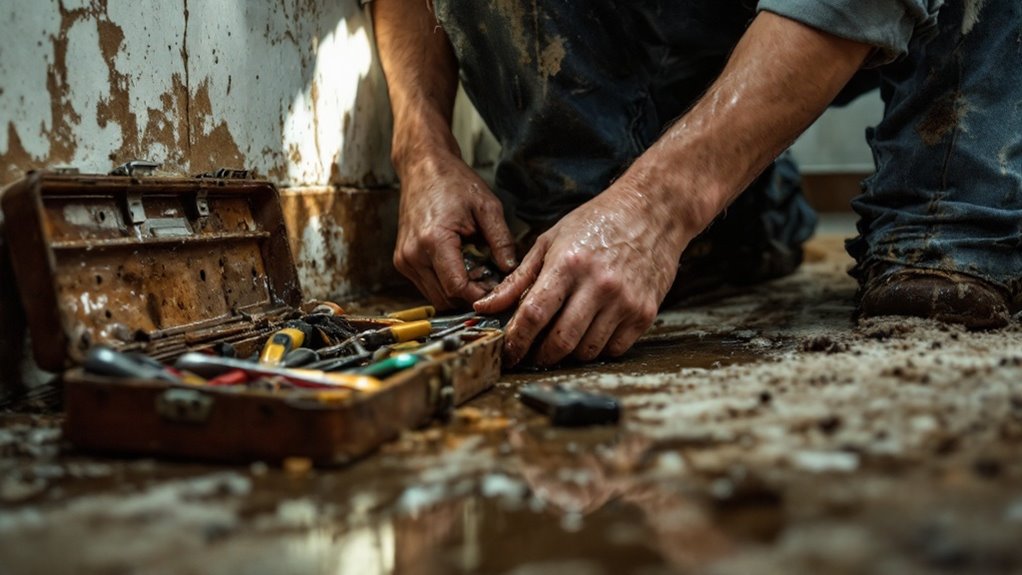You might think that water damage is just a minor inconvenience until you find yourself facing a much bigger problem. Many homeowners make critical mistakes when dealing with water issues, and these can lead to costly repairs and health risks. It’s crucial to know what to avoid to protect your home and your well-being. Let’s examine the top five mistakes you should steer clear of during this challenging situation.
Key Takeaways
- Identify and address the source of water damage immediately to prevent recurring issues and mold growth.
- Act promptly to clean up water; delays can lead to worsening damage and increased costs.
- Document all damage thoroughly with photos and notes for insurance claims and recovery processes.
- Always use proper safety gear to protect yourself from contaminated water and potential hazards.
- Avoid DIY repairs without expertise, as improper handling can lead to more significant problems and costs.
Ignoring the Source of the Water Damage

When you encounter water damage, it’s crucial not to overlook its source, as ignoring it can lead to more extensive problems down the line. Start by identifying where the water is coming from. Is it a leaky pipe, a broken appliance, or perhaps an issue with your roof? Each source requires a different approach to fix the problem effectively. If you don’t address the root cause, you might find yourself facing recurring damage, mold growth, or structural issues. Once you pinpoint the source, take immediate action to repair it. This not only prevents further damage but likewise saves you time and money in the long run. Remember, a proactive approach today can help you avoid bigger headaches tomorrow. Regular inspection of broken pipes is essential to prevent leaks from escalating into significant water damage.
Delaying the Cleanup Process
Ignoring the source of the water damage can lead to another mistake: delaying the cleanup process. When water seeps into your home, every moment counts. If you wait too long to address the issue, the damage can worsen, leading to mold growth, structural problems, and higher repair costs. It’s tempting to put off cleanup, especially if you’re feeling overwhelmed, but acting quickly is essential. Start by removing any standing water, drying out affected areas, and ensuring proper ventilation. Don’t underestimate the importance of timely action—your home’s integrity depends on it. By prioritizing cleanup, you’ll not only protect your property but likewise your health and safety. Remember, the sooner you act, the better you can mitigate the damage. Professional water damage restoration services are available 24/7 to assist you with rapid response services, ensuring a swift and thorough cleanup process.
Failing to Document the Damage

Failing to document the damage can greatly hinder your recovery efforts. When water damage occurs, taking clear photos and notes is essential. These records will serve as significant evidence for insurance claims and repairs. Without proper documentation, you risk losing out on compensation or facing delays in your claim process. Make sure to capture all affected areas, including walls, flooring, and personal belongings. Furthermore, note any actions you take during cleanup, as this can demonstrate your proactive approach. Don’t rely solely on your memory; details can fade quickly. By thoroughly documenting the damage, you’ll strengthen your case and streamline your recovery process, making it easier to get back to normal. Additionally, it’s important to understand the water damage restoration process, as this knowledge can help you provide more effective documentation to your insurance provider.
Not Using Proper Safety Gear
As you tackle water damage cleanup, it’s vital to prioritize your safety by using proper safety gear. Water can be contaminated, and exposure can lead to health issues. Start with gloves to protect your hands from chemicals and debris. Wear a mask to avoid inhaling mold spores and dust, especially if the area is damp. Safety goggles are important to shield your eyes from splashes and harmful particles. If you’re dealing with standing water, rubber boots can keep your feet dry and safe from electrical hazards. By equipping yourself with the right gear, you minimize the risk of injury and illness, allowing you to focus on effectively restoring your home without compromising your well-being.
Attempting DIY Repairs Without Expertise

While it may be tempting to tackle water damage repairs on your own, lack of expertise can lead to more significant problems down the line. You might think you’re saving money, but improper repairs can result in costly issues like mold growth or structural damage. It’s vital to recognize when you need professional help.
| Common DIY Mistakes | Consequences | Professional Solutions |
|---|---|---|
| Ignoring hidden moisture | Mold growth | Thorough moisture assessment |
| Using the wrong materials | Ineffective repairs | Quality material selection |
| Skipping safety measures | Personal injury | Safety-first approaches |
| Misestimating damage | Increased repair costs | Accurate damage evaluation |
| Overlooking insurance | Financial loss | Expert claims assistance |
Consider consulting professionals to guarantee proper and lasting repairs.
Conclusion
When water seeps into your home, it can feel like a silent storm brewing. By avoiding these common mistakes, you can be the calm before the chaos. Address the source swiftly, document the damage like an artist capturing a fleeting moment, and don’t forget your safety gear—it’s your armor. Remember, while DIY might seem tempting, sometimes it’s wiser to call in the experts. Protect your home, and let it weather this storm with your careful guidance.
